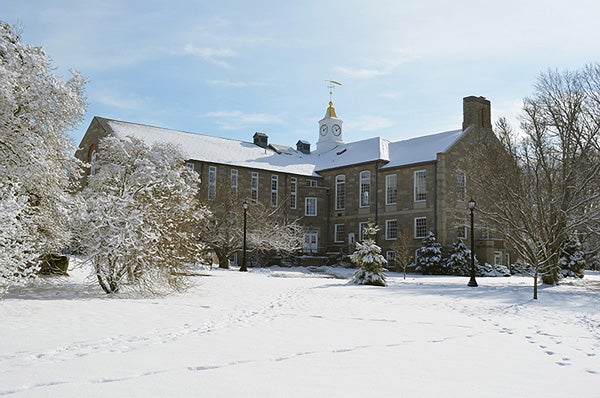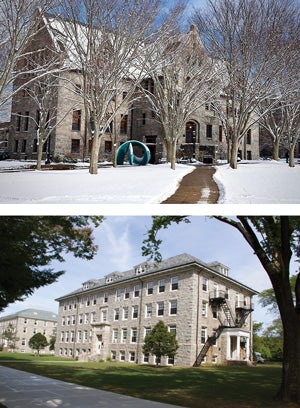Kingston Campus Core Listed on National Register of Historic Places

The U.S. Department of the Interior’s National Park Service has recognized the core of the University of Rhode Island’s main campus in Kingston as a historic district, adding it to the National Register of Historic Places.

Above: A view of Washburn Hall and East Hall.
“This federal distinction recognizes the buildings’ contributions to the history of education, architecture and landscape architecture,” said Jeffrey Emidy, acting executive director of the Rhode Island Historical Preservation & Heritage Commission.
“While many schools have buildings that share a common architectural vocabulary, few have maintained those common forms, styles and materials over time to the degree found on the URI campus,” said Paul R. Lusignan, a historian with the National Register of Historic Places, National Park Service.
The new Historic District includes approximately 29 acres around the grassy, tree-lined quadrangle of the Kingston campus. The oldest structure in the district is the Oliver Watson Farmhouse (circa 1796), part of the farmland purchased in 1888 to establish the agricultural school that would one day become URI.
Structures in the University of Rhode Island Historic District
Watson Farmhouse (ca. 1796)
Taft Hall (1889)
College Hall/Davis Hall (1890/1895)
“Old Ben Butler” Civil War cannon (1861, brought to campus in 1892)
Lippitt Hall (1897)
East Hall (1909)
Ranger Hall (1914)
Washburn Hall (1921)
Bliss Hall (1928)
Edwards Hall (1928)
Rodman Hall (1928)
World War I Memorial Gateway (1922 and 1928)
President’s House (1931)
Green Hall (1937)
Quinn Hall (1937)
Eleanor Roosevelt Hall (1937)
Robert L. Carothers Library and Learning Commons (1964, ’75, ’92-’93)
The district is bound roughly by Upper College Road on the east, Campus Avenue on the south, Lower College road and Farmhouse roads on the west, and the eastern portion of Alumni Avenue on the north. Most of the buildings in the district, particularly those that were built for academic use, are a few stories tall and are constructed of quarry-faced granite ashlar. Some of that stone was harvested from now-closed quarries on campus.
“I am pleased to see our beautiful campus gain recognition and protection through this significant designation,” said URI President David M. Dooley. “We at URI have long cherished the buildings and landscape that comprise an important part of our unique identity and stature in higher education. It is gratifying to see our contributions recognized, and for that recognition to come, fittingly, at the close of our yearlong 125th anniversary celebrations.”
 Home
Home Browse
Browse Close
Close Events
Events Maps
Maps Email
Email Brightspace
Brightspace eCampus
eCampus


